Egyptian Walking Onions: plant them once, enjoy them forevermore & anon
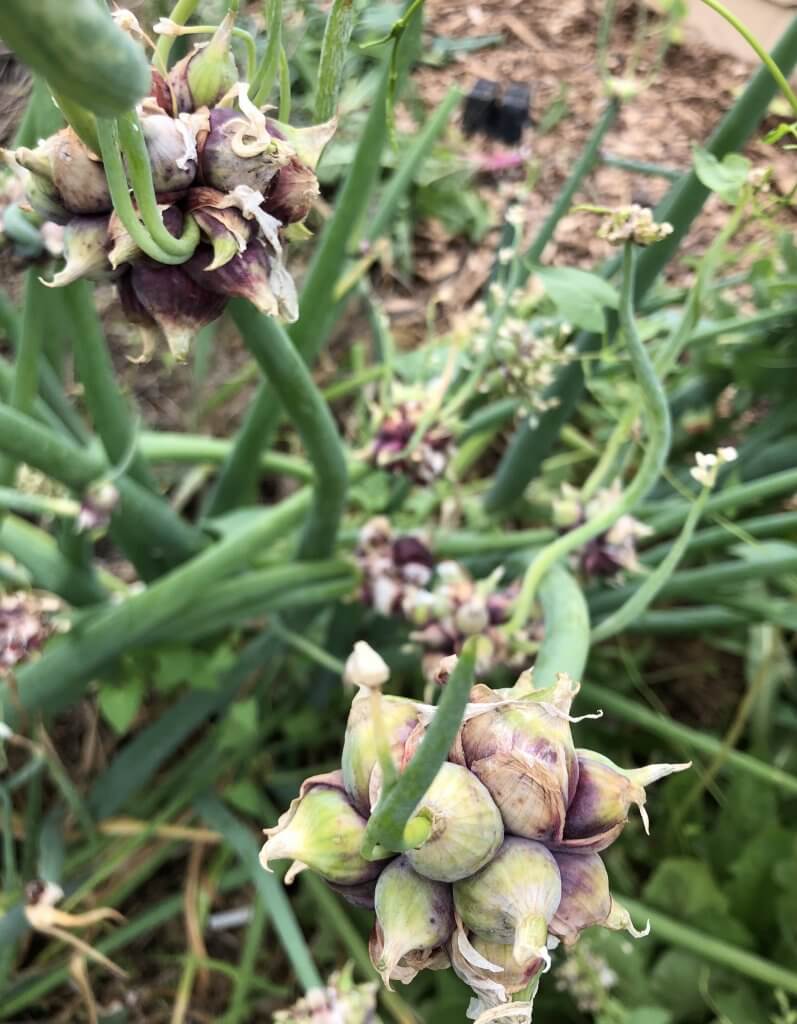
Question: What the heck are Egyptian Walking Onions?
Answer: Read on, grasshopper. Read on and learn. But first, a multi-prologue to our oniony exposé.
Prologue, Part 1: On Shortages and Substitutions
During our church’s potluck last Sunday, the subject of toilet paper came up (as it does), in the context of shortages. In the time frame of the month of March, year 2020.
“Remember the toilet paper shortages last spring?” somebody asked. (And of course, nobody had forgotten them; they are quite memorable. IN FACT one woman murmured that those shortages had made such an indelible impression on her that she still kept several enormous bales of toilet paper pushed underneath her bed, in readiness. Just in case. A toilet paper prepper, you might call her.
*okay, that was me*
“I suppose folks hoarded toilet paper because there’s not exactly a substitute for it . . . ” I the witless woman added, weakly, when met with guffaws of delight at the vision of a hoard of toilet paper underneath her bed danced in their heads.
My parents, both well into their eighties, remember years of real shortages, not panic-buying-driven ones. Not politically-motivated ones, either. They added to the conversation with their matter-of-fact observations at this time.
“We used the Sears & Roebuck catalog,” said my Dad, simply. “We just kept it out there in the outhouse. The last year’s copy, of course.”
I thought about all the huge packages of Charmin and White Cloud underneath the bed and suddenly felt a little spoiled.
“Or corncobs,” added Mom. “Some of them weren’t that rough. Kinda scratchy, though.” A lot spoiled. “The catalogs were nicer, but they didn’t always last the entire year.”
We let that sink in for a bit.
Okay, okay, so there are substitutes for toilet paper. We are spoiled rotten brats who’ve never had to collect corn cobs for the outhouse.
So. Perhaps the things we ought to be storing and buying extra of, in case of shortages for whatever reason, are things for which there aren’t any substitutes.
Food. Protein. Grains. Alliums. Especially alliums.
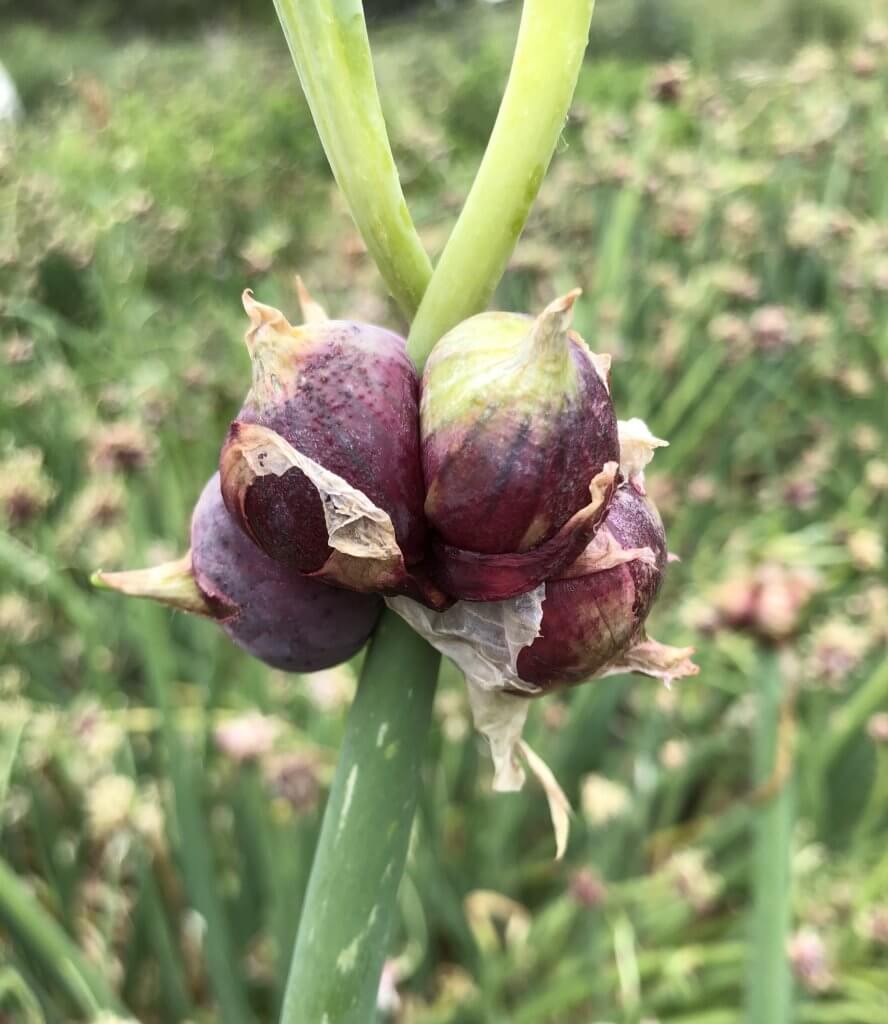
Prologue Part 2: Shakespeare agrees
[Tweet “Mine eyes smell onions; I shall weep anon” . . . Lafeu from Shakespeare’s All’s Well that Ends Well””]
Prologue Part 3: The Housewife weighs in
and Prologue the Fourth Part: A fictional story, purely from my imagination–Scout’s honor.
Say your husband comes home a little early from work, and you can tell from the screech of gravel in the driveway and the sharpish slam of the car door that he’s not in A Mood to wait overlong for his dinner, and you’ve actually been taking it a little easy this afternoon so supper’s barely a thought at this point.
Do the following:
- Toss a bit of fat–bacon fat is best, but butter or olive oil will work too–into a cast iron skillet,
- Heat it up quickly and then–quickly, quickly! lives are at stake–
- Dice an onion and/or garlic into the skillet and stir it around with a wooden spoon as he comes into the kitchen.
- Smile winsomely at him, as if everything supper-related is totally under control. He will relax, and the smile he gives you will be one of hope and gratitude.
You’ll have a few more minutes at this point, as you stir those chopped alliums around the pan, to figure out what you’re going to make for dinner, but a sautéed onion–with or without garlic–is a starting point of many a fine meal. (See Prologue Point #3 above.)
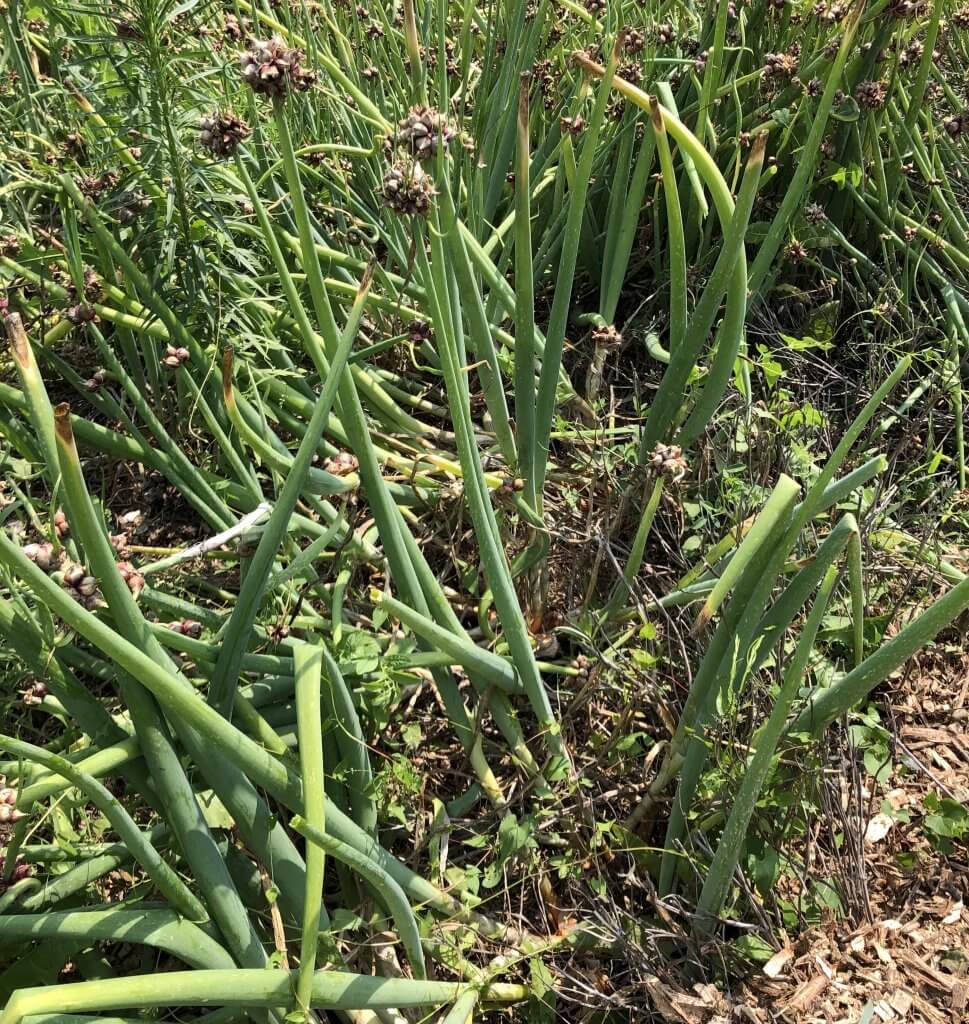
. . . and #5: A Cautionary Tale of Lack
My dear friend and fellow absurdly-productive gardener Bob had a lovely garden in his back yard, year after year. It had finite boundaries, however, his being a town dweller. I offered him starts for Egyptian Walking Onions a few times, and he said “No, thank you. I don’t have any, and I don’t want any.”
Bob has moved away, sadly, and every time I drive past his little former backyard garden, I miss seeing the onions that surely would have taken over that little space by now. Think of the wealth of onions that were never to be. Sad.
A Picture of Scout
since she was mentioned

Scout: Pleading for a walk, in the only way she knows how: by sharp, ear-splitting barks and piteous pleading looks. (She got one right after I snapped this photo.)
Answer to the Question
I had to warm up a bit to the subject of onions, but warmed up I now am!
Egyptian Walking Onions are not, in fact, Egyptian at all! They are a cross, as a matter of fact, of the common cultivated onion, Allium cepa, and the Welsch onion, Allium fistulosum. If you want to sound quite intelligent, by the way, refer to EWOs by their very fancy Latin name: Allium x proliferum.
As in: “Mack, would you run out to the garden and dig up a clump of Allium x proliferum for dinner, please?
The common name (Walking Onions) refers to this plant’s habit of “walking” across the garden. Instead of flowers, this plant produces topsets–clusters of cunning bulbils–at the top of the stalk where the flowers and seeds would normally be. The stalks will eventually flop over from the weight of the bulbils (if not harvested) and replant themselves, thus beginning their “walk” across the ground.
My sister actually plants these in her flower border, as she thinks the bulbils are quite cunning and decorative.
Egyptian Walking Onions are thought to be originally native to India or Pakistan, then later introduced into Europe by the Romans. So it makes total sense that they are now called “Egyptian.” hmm.
EWOs couldn’t be easier to plant and grow. You simply stick the bulbils into some fertile soil in the fall, a few inches apart, and they’ll send up shoots. Next spring, they’ll come up with gusto, and you can either dig them up and use them like green onions, or you can be selective and leave some to go to seed (i.e. produce the cunning topsets) which you can then pick and re-plant, or allow to “walk” across your patch!
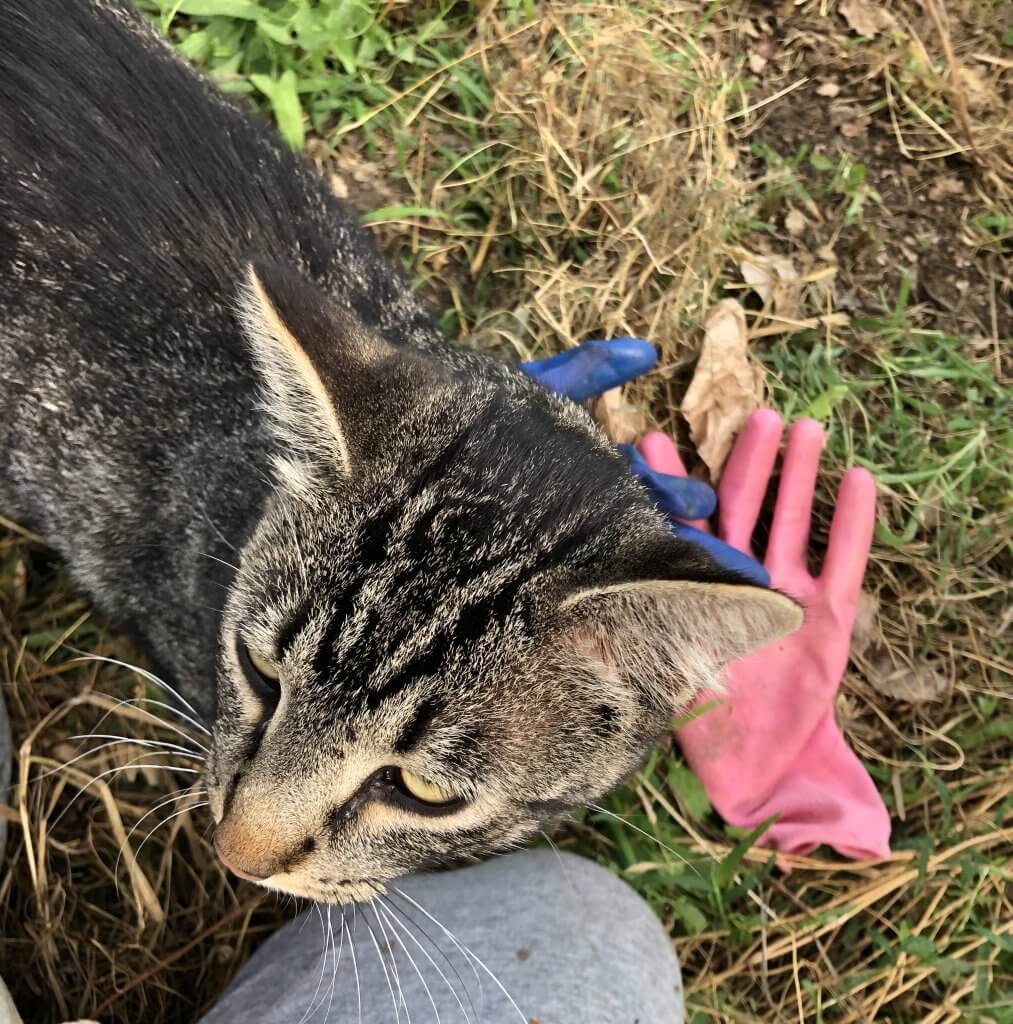
Sometimes you have to take the gloves off and give the cat a good petting.
A Caveat
Here’s the caveat, which I alluded to in the #5 Prologue above: you need to either fence these babies in, or allow them plenty of space. My friend Bob knew that his space was finite. EWOs can take over a big space pretty happily, if you let them do it. It does take awhile, though. They aren’t mint, after all. But they do bear watching. So you can do what I do–aggressively harvest, use, and police the buggars, or you can plant them in a finite space–a raised bed, a huge pot, etc.
Bottom line: if you pick the little bulbils and share, eat, or plant them, the patch will stay the same size. It’s only in the bulbil-dropping that they will “walk” and at that, they’ll only move two to three feet at a time.
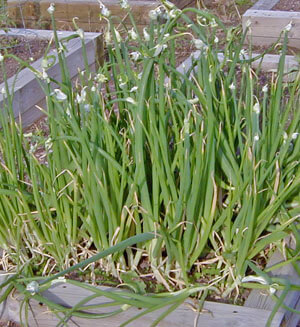
A bed of EWOs surrounded by landscape timbers. Photo credit https://hort.extension.wisc.edu/articles/egyptian-walking-onions/
The EWO Season
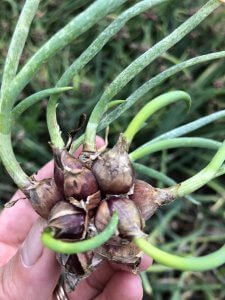
Early Spring: the raggedy-looking clumps of EWOs that have made it through the winter (yes, they are quite hardy) begin to put up new fresh shoots. You can trim these up and use them in salads. It’s super early in the spring, so you can imagine how good they taste!
Late Spring: The new shoots have developed into beautiful bonafide green onions, and you can dig them as you like, and eat them. They taste so good!
Early Summer: The topsets begin to form in wild and delightful disarray. This is a picturesque time for the EWOs and if you are a visual person like me, you’ll spend way too much time out in the onion patch, photographing and admiring the wildly creative little clumps of bulbils. The flower stalks are edible, but the least desirable part of the plant, in my opinion. They become sharp-tasting and are a little tough.
You can harvest the bulbils and plant a new row, or you can do all manner of things with them: you can eat them, pickle them, or peel and chop them up in your stir-fries. They are so cute and so tasty! You can also share them with your friends (not with my friend Bob, though).
Or you can take the easy way out and let them do their thing: walk over and plant the bulbils on their own. Who knows? Maybe the mother plant knows best.
Late Summer/Early Fall: The bulbils you might have missed picking (it’s easy to do) or the ones that dropped to the ground behind your back, begin to put up shoots. Within a few days or a couple weeks, you’ve got an entirely new batch of delicious green onions, which you can harvest and use (or chop up and freeze for winter use) or leave in place for larger green onions and bulbil factories the next spring.
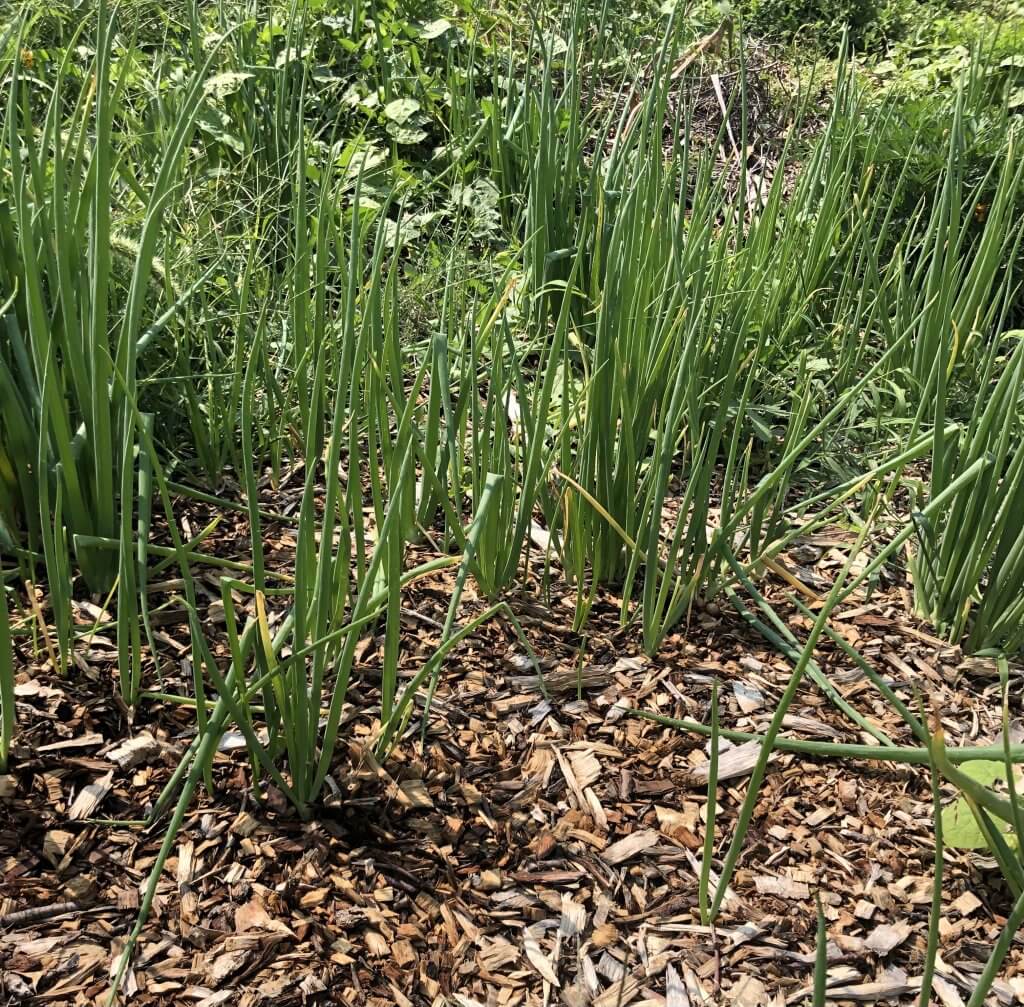
This is what my onion patch looks like right now! Green onions in delicious abundance!
How Simple is That?
If you’ve read this far, I know you must be a die-hard onion fan, OR you’re interested in growing some of these in your garden OR you’re fascinated by any sort of perennial foods. Possibly all three!
Fall is the optimal time to plant EWOs, since they can then develop a strong root system to make it through the winter, and then grow quickly the following spring.
One more thing
Did you know that allium bulbs, such as the EWOs, are among the best bulbs to be planted in the fall?
Here are a few more: Tulips, Daffodils, Hyacinth, Crocus, Snowflakes, Starflowers, Grape Hyacinth, Scilla, Dutch Iris, Garlic, Lilies, Bearded Iris, Daylilies, Peonies, Lycoris, Fritallaria, Oriental Poppies, Foxtail Lilies and more.
Bulbils Soon in Stock for Little Ol’ You
Next month, I’ll be making EWO bulbils available from our little farm, for fall planting. I’ll include the orders with complete planting directions, and a bonus: one of my favorite recipes for how to use these lovely perennial onions.
If you’ve been poking around online, you’ll notice that many seeds and food crop starts are already out of stock! That is not a good place to be. I hope the seed stores and the nurseries will re-stock so we can continue to grow as much of our own food as we choose. I believe it’s more important now than ever to learn how to grow your own food, in the current era at least.
One very easy thing you can do, if you’re interested in learning how to grow your own food, is to plant EWO bulbils. You will have onions in your garden forevermore and anon. They are extremely easy to grow, and easy to care for. Once you’ve planted them, you’ve got them. That’s food security there, at least where alliums are concerned!
Be sure to share your email address with me in the little box above, below my face. You’ll be sure to hear when the bulbils are ready to ship!
Take care. Love your peeps. Get to know your neighbors. Serve God. Speak the truth. Floss your teeth.
And remember that I love you and am pulling for you. (I mean it!)
*hugs*
p.s. I would love, love love to hear what your favorite perennial crops are! Please leave me a comment below. Do you grow EWOs?
- Heirloom tomatoes: 9 favorites I’ll grow again! An occasional analysis.
- Fermented Cherry Tomatoes: ooh la la!


EWO are prolific in my raised bed south of the patio. And in the former compost area of my garden by the rhubarb. They are a lot like Lamb’s Ear plants which like to grow where I really don’t want them, like the yard instead of staying in the flower bed.
My sage is perennial in the raised bed to the north of the patio. Some years my thyme is too, in it’s big crock east of the patio (sensing a theme here?) (PS There is no West of the patio, that would be the house.)
I’m watching my new rhubarb in the new raised bed south of the wash house (new theme). They both died back but are now putting out new shoots. The soil is very poor there as DFarmer used some old ditch dirt. I think I’ll need to replant them or add LOTS of compost.
And finally, I have 2 lovely Elderberry plants that gave me lots of berries for the freezer to be made into syrup soon. I left some for the birds as well.
Kay, you’re busy, girl, with all those beds. Your place sounds a lot like mine. I stick a lot of plants wherever there’s a space for them. And–you have a wash house? tell me more!
I grow Welsh onions. I don’t use a lot of big onion bulbs in my cooking, or fresh slices, so when I do I just buy one (and then just use part of it and chop and freeze the rest). I like the taste but not the texture, the slime of them! Welsh onions are perfect for me when I just need a bit of onion or green onions. I grew them from seed originally for the flowers.
I have artichokes and blueberry bushes. Loads of herbs, but I don’t think of those as “crops” just taking a leaf or two. Oh, I planted new strawberries this year, and raspberries again. This time gold ones.
Lisa–artichokes! Blueberries! I don’t remember what state you live in. You are, however, the first person I’ve known who grows Welsh onions. Gold raspberries–yum!
Amy – you might remember that once when we were delivering to Wilderness Ridge I pointed out the acreage where we used to live before we bought our present farm. The place near 14th and Saltillo Road. Well, we left there 19 years ago, but I drive by the place regularly and I am amused to see a patch of EWOs I planted maybe 21 years ago. The only “care” it has received since we left is to be mowed several times per year and the clump is slowly growing. Tough plants! Put me down for some of those bulbils – I will plant them this fall in a new raised bed surrounded by concrete blocks!
Gene, I do remember that place! EWOs are such tough plants. I know I have photos of them, somewhere, covered in snow. You can snip off leaves until the very coldest days of winter, when they will droop and look very sad. Everybody ought to have these growing someplace. I’ve thought about dropping bulbils around my fruit trees. I think the trees would probably benefit. I’ve read that they are good companions.
How intriguing! I planted flat leaf garlic chives 25 yrs ago and now they’re @ 1/8 acre solid not to mention in the woods everywhere! There’s a 4×8 bed that’s solid chive too
I’d love some of the bulbs if they’re available, I’m in Ma.
Thank you for such enlightening and honest articles!!!!
OH goodness, girl, those garlic chives are just crazy prolific! They do have such pretty little white flowers, don’t they? I’ll bet they look quite pretty in your woods. I have a couple pots full of them, but haven’t been brave enough to plant them out!
Amy, I look forward to reading all things written by you, and this is no exception! We love onions, and I had my first bumper crop this year from a raised bed specifically for them. I go through a LOT of onions so I may have to double my planting next year. I want to have a dedicated garlic bed but everybody seems to always be out of stock! Please put me down for an order of the walking onions. I’ve always wanted some but never got any….now is the time! My favorite perennial would have to be my goodness blackberries as well as my even sweeter WILD bkackberries. Can the honey produced from my bees be considered a perennial crop? Of COURSE it can! I love my bees and they work so hard for me and themselves.
Oh, absolutely! Honey is a gift! I ought to start some thornless blackberries. I love my old-fashioned thorny ones, but OH the pain whenever I get snagged by the thorns!
I should proof read before posting! Those would be THORNLESS blackberries! Lol
haha! I chalked that up to that ornery autocorrect, Sharon!
Yes to the EWOs! How fun to hear about something unfamiliar yet so easy! I have lots of perennials here on our 15 acres in NE Ohio: raspberries, blueberries, grapes, strawberries, asparagus, mint, and of course the fruit trees as well as the other commenter’s approved use of honey as a perennial! Since our honey counts, I’m also adding eggs from the chooks!
I’ve had REALLY bad luck with these. Lots of couch grass here and THREE times, despite repeated weeding, the grass choked out my onions!
Amazing! Mine always choke out everything else! Your grass must be formidable!